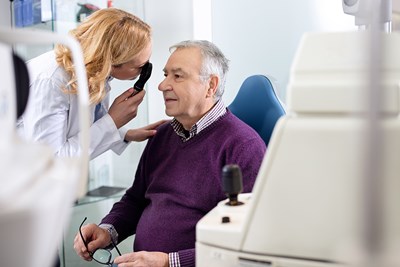Strabismus is a disorder characterized by weakness of the eye muscles. While normal eye muscles move more or less in tandem, allowing the eyes to focus simultaneously, eyes affected by strabismus tend to focus on two different things, as one eye seems to wander either up, down, left, or right compared to the normal eye (although both eyes may have muscular issues), and the brain receives two separate images.
Eventually, the visual center starts ignoring images sent by the weaker eye, which can lead to amblyopia. There are effective treatments for strabismus, however, and the sooner treatment begins, the easier and more effective it generally is. The first step of managing strabismus is receiving an accurate diagnosis.
Optical Exam
The cause of strabismus in children is largely unknown and often congenital; there does, however, seem to be a genetic link. The American Academy of Ophthalmology (AAO) recommends vision screenings for all children around age 3 -- earlier if either side has a family history of strabismus, amblyopia, or extremely poor vision. This screening can be performed by a pediatrician or other pediatric optic specialist. Poor results generally means the child should visit an eye doctor, or ophthalmologist.
Strabismus can also be brought on by issues acquired later in life, such as Grave’s disease or a stroke. Adults should have an annual eye exam anyway, but go in earlier if you notice a change in vision.
Visual Acuity
If your doctor suspects strabismus, the first step in diagnosis is a full optical exam. This includes questions about your history, as well as any familial history that may be pertinent to diagnosis.
A visual acuity test determines how strong the vision of either eye is. Normal, or perfect, vision is considered 20/20; this means the person in question can see at 20 feet what someone with perfect vision can see at 20 feet. 20/50 vision means what you should see at 50 feet, you can’t see until you are only 20 feet away. This can be different in both eyes. While a visual acuity test normally uses a chart with lines of letters in different sizes, alternative methods can be used for very young children (or others with difficulty speaking or naming letters).
Additional Optical Tests
Refraction allows your ophthalmologist to determine the appropriate prescription for corrective lenses, if needed. According to the AAO, other tests will be used for alignment and focusing, which allows your eye doctor to “assess how well your eyes focus, move and work together.” Essentially, it is a means of discovering why your eyes fail to focus on a single object or move in tandem. The “cover/uncover” test involves looking at a single object, while the doctor covers each eye separately; movement may be indicative of the presence of strabismus, as the eye is forced to refocus on the object in question.
Other tests that may be necessary include a retinal exam or corneal light reflex, while still other tests may be necessary to examine your eyes anatomy, particularly for any optical diseases that may be inducing the onset of strabismus.
Neurological Testing
Neurological testing, or an examination of the brain and spinal cord, are also generally a part of diagnosing strabismus, particularly depending upon the suspected underlying cause. For example, according to Merck Manual “neuroimaging may be necessary to identify the cause of acquired cranial nerve palsies.”
Once the visual tests have been completed, your doctor can prescribe corrective lenses, if necessary, to begin the treatment process. If other eye disorders are present, these may also need to be dealt with before taking additional steps to manage strabismus. If you suspect you or your child has strabismus, schedule an appointment with your doctor as soon as possible.



